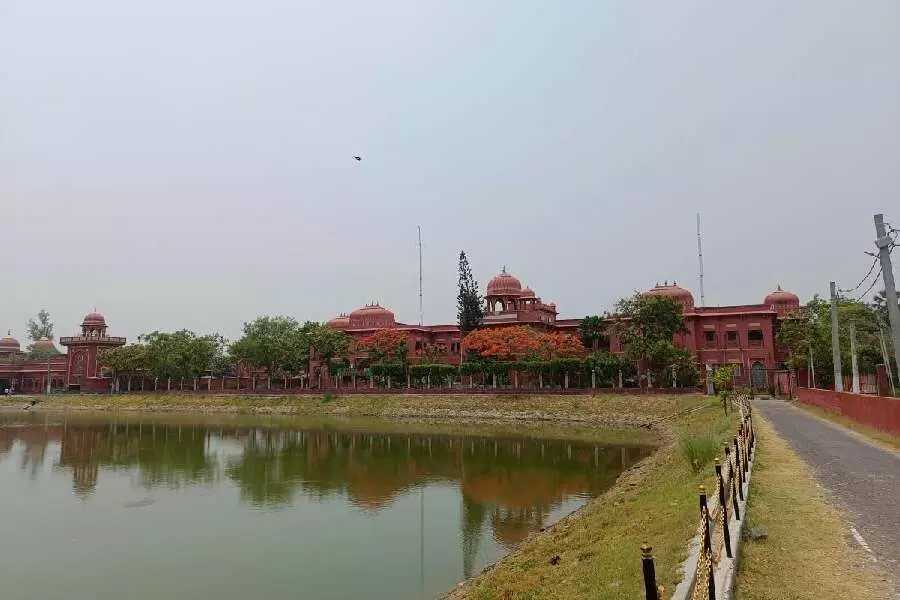Waves rippled across the lakes of the Darbhanga Raj Palace as a cool easterly wind, tinged with the smell of rain and election bustle elsewhere, caressed past.
The vast complex is surprisingly clean, giving it an incongruous, otherworldly charm. Two state universities operate out of campus. But as soon as you step outside, all the splendor of the throne of Mithila state and culture vanishes.
And Bihar begins.
Noise, filth, pollution, traffic jams and severe waterlogging when it rains – the smell of rot outside.
“We were the center of art, culture and power in and around these parts of the country – Mithila. Whatever was best and modern and available in India was present here also. It was a progressive state. But things turned sour,” Maharaja Kapileshwar Singh, a descendant of the erstwhile Darbhanga Raj, tells The Telegraph.
Established in the 16th century, Darbhanga Raj once spread over 10,000 square km. It became a zamindari under British rule in the 19th century, but was counted among the largest and richest of the princely states, with more powers than many princely states. The palace’s ivory collection is still considered one of the best in the world.
The Raj had its own sugar mills, railway services, aviation, irrigation systems and power generation units but the destruction was so severe that even their remains have become difficult to find.
Singh – who is seen at functions organized by the BJP, but claims he has “not joined any political party” – refuses to elaborate on the reasons for the downfall, saying it is “a long story”. It will take a lot of time to tell.”
In other parts of the country, people look at the descendants of the royal family with respect, but not here. The situation deteriorated rapidly after the death of Kameshwar Singh, the last absolute Maharaja of Darbhanga, in 1962.
“I grew up listening to my grandparents’ stories of the grandeur of Darbhanga. Its decline has been caused by politics and politicians who did nothing to protect it. I don’t really know whether our votes have done any good in the last seven decades,” says Kushagra Thakur, an engineer with a multinational company in Pune, who is back home for the elections. “People are also politically oriented, undisciplined and impose politics on everything.”
The tendency of people not to accept anything without testing it on the basis of logic is the result of the tradition of ‘dialectics’ here since the time of King Janak of Mithila, father of Sita.
“Darbhanga’s dominance was due to its meritocracy and intelligence-based culture. Because of the Maharaja it was the center of Mithila and center of various activities. It declined when it resorted to nepotism and casteism,” Professor Jitendra Narayan, head of the political science department of Lalit Narayan Mithila University in Darbhanga, told The Telegraph.
“Politicians promoted casteism for political gains. He neither batted nor wanted to maintain the grandeur of Darbhanga. Take the example of its unique drainage system that will protect the city despite being at a lower level than the nearby Bagmati River. People have now built houses on the drainage route,” says Narayan.
Eight candidates are in the fray for this seat spread across six assembly constituencies with about 17.75 lakh voters. The main contest is believed to be between sitting BJP MP Gopal Ji Thakur and RJD’s Lalit Kumar Yadav.
Like most parts of Bihar, groups of people are seen busy discussing caste equations, as this is a constituency where Brahmins outnumber all other groups. They are followed by Muslims, Mallahs (boat people and fishermen), followed by others. The two main contestants are also weighed in.
“Till the time Gopal was an ordinary BJP worker, he was polite, but after becoming an MP, he became arrogant. He no longer meets his own party workers, nor does he go door-to-door to listen to voters. Lalit, on the other hand, is good on both fronts,” says Vijay Panjiyar, a shopkeeper at Beta Chowk in Darbhanga city.
A few kilometers away, the Khadi Village Industries Center of Darbhanga is also in a dilapidated condition. Employees say that the Narendra Modi government has stopped central assistance since coming to power and the industry is fast dying.
Accountant Shiveshwar Jha says that at a time when the center had 4,000 charkhas, 200 weavers, 20 tailors and five dyers besides thousands of women producing hand-spun yarn, today there are only 22 employees, five weavers and one dyer. ,
“Now we barely supply clothes worth ₹7 lakh to ₹8 lakh per year. We barely get ₹5,000-6,000 per month and can barely survive,” he adds.
But voters still have hope. “Darbhanga can have a bright future. It has an airport, a good rail and road network, colleges and fertile land. We need politicians who pay attention,” says advocate Kumar Sarvesh.
